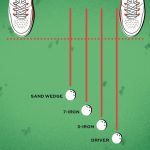To drive a golf ball 300 yards, ensure proper grip, stance, and swing technique. Focus on generating maximum clubhead speed and solid ball contact.
Driving a golf ball 300 yards is a remarkable feat that requires precision and power. Golfers need a combination of proper technique, physical strength, and equipment suited for long drives. Start by maintaining a strong grip and a balanced stance.
The swing should be smooth and controlled, focusing on generating maximum clubhead speed at impact. Regular practice and physical conditioning can significantly improve your driving distance. Using the right driver with a suitable shaft flex and loft also plays a crucial role. Mastering these elements can help you achieve impressive driving distances on the golf course.

Credit: golf.com
Choosing The Right Equipment
Driving a golf ball 300 yards requires skill and the right equipment. The right equipment can make a big difference in your game. Let’s dive into choosing the right tools to achieve this goal.
Selecting The Driver
Choosing the right driver is crucial for long drives. Look for a driver with a large sweet spot. This will help you get more distance even on off-center hits.
Consider the loft of the driver. A loft of 9 to 11 degrees is ideal for most players. This loft range helps in achieving the perfect launch angle for maximum distance.
The shaft of the driver also matters. A flexible shaft can add more distance to your shots. If you have a fast swing speed, choose a stiff shaft. For slower swing speeds, a regular or senior flex shaft is better.
| Driver Aspect | Recommendation |
|---|---|
| Sweet Spot | Large |
| Loft | 9 to 11 degrees |
| Shaft Flex | Based on swing speed |
Optimizing Ball Choice
The right golf ball can add yards to your drive. Choose a ball that matches your skill level and swing speed.
For beginners, a ball with low compression is best. This type of ball is easier to hit far. Advanced players may benefit from high-compression balls. These balls offer more control and spin.
Consider the cover material of the ball. Urethane covers provide better feel and control. They are ideal for advanced players. Surlyn covers are more durable and offer less spin. They are perfect for beginners.
- Low compression balls for beginners
- High compression balls for advanced players
- Urethane covers for control
- Surlyn covers for durability
Mastering The Grip
One of the key elements to driving a golf ball 300 yards is mastering the grip. The grip is your only connection to the club, so it’s crucial to get it right. A proper grip ensures better control, more power, and greater accuracy. Let’s explore the elements of a perfect grip.
Proper Hand Positioning
The position of your hands can greatly affect your swing. Follow these steps to achieve the correct hand positioning:
- Left Hand: Place your left hand on the club first. The club should run from the base of your pinky to the middle joint of your index finger. Close your hand around the grip.
- Right Hand: Place your right hand below your left hand. The club should rest diagonally across the fingers. Wrap your right hand around the grip, with your right pinky overlapping the left index finger.
Grip Pressure
Grip pressure plays a huge role in your swing. Too tight, and you’ll lose flexibility. Too loose, and you’ll lack control. Follow these tips for the perfect grip pressure:
- Light but Firm: Your grip should feel like holding a bird. Firm enough not to let it fly away, but light enough not to hurt it.
- Consistent Pressure: Maintain the same grip pressure throughout the swing. Avoid tightening or loosening your grip at any point.
| Grip Aspect | Tip |
|---|---|
| Hand Positioning | Left hand first, right hand below |
| Grip Pressure | Light but firm, consistent throughout |
Mastering the grip is the first step to driving a golf ball 300 yards. Ensure your hands are positioned correctly and maintain the right grip pressure for optimal performance.
Perfecting Your Stance
Driving a golf ball 300 yards requires more than strength. It demands a perfect stance. Your stance sets the foundation for a powerful swing. Let’s explore the key elements of perfecting your stance.
Feet Placement
Your feet placement is crucial for balance. Place your feet shoulder-width apart. This helps in maintaining stability. Ensure your weight is evenly distributed. Your right foot should be slightly back. This position allows for a better swing path.
Body Alignment
Proper body alignment improves accuracy. Align your body parallel to the target line. Your shoulders, hips, and feet should be in sync. This alignment ensures a straight shot. Slightly tilt your spine away from the target. This tilt helps in achieving a powerful upward swing.
Checklist For Perfect Stance
- Feet shoulder-width apart
- Even weight distribution
- Right foot slightly back
- Body parallel to target line
- Spine tilted away from target
Common Mistakes
- Feet too close together
- Weight not evenly distributed
- Misaligned body parts
- Improper spine tilt
The Backswing
The backswing is critical for driving a golf ball 300 yards. It sets the stage for power and accuracy. A proper backswing ensures you generate maximum club speed. Let’s dive into the details.
Initial Movements
Begin your backswing with a smooth takeaway. Keep your arms straight and rotate your shoulders. Your weight should shift to your back foot. This builds a strong foundation.
Maintain a steady head position. Your eyes should stay on the ball. A stable head helps with balance and control. The clubhead should move back low and slow. This keeps the swing on plane.
Focus on your hands and wrists. They should stay quiet during the initial movement. This prevents early hinging and ensures a smooth transition.
Top Of The Swing
At the top, your club should be parallel to the ground. Your left arm should stay straight. This creates a wide arc for maximum power.
Your right elbow should fold naturally. This helps maintain the correct swing plane. Your shoulders should be fully rotated. Your back should face the target.
Ensure your weight is on your right side. This prepares you for a powerful downswing. Your hips should stay stable. This provides a strong base for your swing.
Avoid overswinging. It can lead to loss of control. Keep your swing compact and controlled.
| Key Points | Details |
|---|---|
| Initial Movements | Keep arms straight, rotate shoulders, shift weight to back foot. |
| Top of the Swing | Club parallel to ground, left arm straight, right elbow folded. |
Executing The Downswing
Mastering the downswing is crucial to hitting a golf ball 300 yards. This section will guide you through the essential elements of a powerful downswing. Focus on weight transfer and hip rotation to maximize your drive distance.
Weight Transfer
Weight transfer is the first step in executing the downswing. Proper weight transfer adds power to your swing.
- Start by shifting your weight to your back foot during the backswing.
- As you begin the downswing, transfer your weight to your front foot.
- Ensure that most of your weight is on your front foot at impact.
Weight transfer is essential for generating speed and distance.
Hip Rotation
Hip rotation is another key element in executing the downswing. Proper hip rotation can help you achieve a more powerful swing.
- Start your downswing by rotating your hips towards the target.
- Keep your upper body relaxed and let your hips lead the motion.
- Ensure your hips are fully rotated at the moment of impact.
Effective hip rotation can significantly increase your swing speed.
| Key Element | Action | Impact |
|---|---|---|
| Weight Transfer | Shift weight from back foot to front foot | Generates power |
| Hip Rotation | Rotate hips towards target | Increases swing speed |
Focus on these elements to improve your downswing and drive the ball 300 yards.
Achieving Maximum Clubhead Speed
Achieving maximum clubhead speed is the key to driving a golf ball 300 yards. It requires proper technique, consistent practice, and mental focus. This section will delve into the crucial aspects of swing mechanics and speed drills to help you unlock your full potential on the golf course.
Swing Mechanics
The foundation of a powerful drive lies in your swing mechanics. Follow these tips to optimize your swing:
- Grip: Hold the club firmly but not too tight.
- Stance: Position your feet shoulder-width apart for balance.
- Alignment: Aim your body parallel to the target line.
- Backswing: Rotate your shoulders fully while keeping your arms straight.
- Downswing: Shift your weight to your front foot and rotate your hips.
- Follow-through: Finish with a high and balanced follow-through.
Speed Drills
Practicing speed drills can significantly improve your clubhead speed. Here are some effective drills:
- Swing with a Weighted Club: Use a heavier club to build strength and speed.
- Use Resistance Bands: Attach bands to your club and practice swinging.
- Perform Speed Swings: Swing your driver as fast as possible, focusing on speed.
- Incorporate Plyometric Exercises: Jumping and explosive movements can enhance your swing power.
- Track Your Speed: Use a launch monitor to track improvements.
Combining proper swing mechanics with dedicated speed drills can help you achieve your goal of driving the golf ball 300 yards. Remember to practice consistently and stay focused on your technique.
Impact And Follow-through
Driving a golf ball 300 yards requires precision in the impact and follow-through stages. These critical moments determine the ball’s speed and direction. Mastering these techniques can significantly improve your driving distance.
Maintaining Control
During impact, maintaining control is essential. Ensure your grip is firm but not tense. A relaxed grip allows better clubhead speed. Stand with your feet shoulder-width apart. Keep your body balanced throughout the swing.
- Focus on the ball’s lower half.
- Keep your eyes on the ball.
- Avoid excessive wrist movement.
Your body should rotate smoothly. This rotation generates power and maintains control. Engage your core muscles for stability.
Finishing The Swing
The follow-through is just as crucial. A proper finish ensures the ball travels further. After impact, continue the swing naturally. Your club should travel upward and outward.
- Allow your hips to rotate fully.
- Your weight should shift to your front foot.
- Keep your head steady until the ball is airborne.
Finish with your chest facing the target. Your arms should extend fully. This extension ensures maximum force is transferred to the ball.

Credit: www.youtube.com
Common Mistakes To Avoid
Driving a golf ball 300 yards is a challenging feat. Many golfers make common mistakes that hinder their performance. In this section, we will discuss these mistakes and how to avoid them.
Incorrect Grip
Your grip is the first point of contact with the club. An incorrect grip can ruin your shot.
- Hold the club with a light but firm grip.
- Avoid gripping too tightly.
- Ensure your thumbs point down the shaft.
Use a neutral grip to keep the clubface square. This will help you achieve greater distance and accuracy.
Poor Balance
Poor balance can negatively impact your swing. Maintaining balance is crucial for a powerful drive.
- Distribute your weight evenly on both feet.
- Keep a stable stance throughout the swing.
- Avoid swaying during your backswing.
Focus on a smooth and controlled motion. This ensures maximum energy transfer to the ball.
Understanding these common mistakes can improve your game. Practice regularly to perfect your technique.
Practice Drills
Driving a golf ball 300 yards is a dream for many golfers. Practice drills play a crucial role in achieving this goal. Drills help improve your technique, strength, and consistency. Here, we’ll focus on effective practice drills to drive a golf ball 300 yards.
Range Routines
Range routines are essential for improving your golf swing. Here are some effective range routines:
- Warm-up swings: Start with slow swings to loosen up your muscles.
- Alignment practice: Use alignment sticks to ensure proper stance.
- Target practice: Aim for specific targets to improve accuracy.
- Distance control: Practice hitting balls to different distances.
Focus on your grip, stance, and follow-through during each routine. Consistency is key to improving your driving distance.
Home Exercises
Home exercises can significantly improve your golf swing. These exercises help build strength and flexibility:
- Core workouts: Strengthen your core with planks and sit-ups.
- Leg exercises: Perform squats and lunges to build leg strength.
- Stretching: Stretch daily to improve flexibility and reduce injury risk.
- Resistance training: Use resistance bands to improve muscle strength.
Incorporate these exercises into your daily routine. Stronger muscles lead to more powerful swings.
| Exercise | Benefits |
|---|---|
| Planks | Strengthens core muscles |
| Squats | Builds leg strength |
| Stretching | Improves flexibility |
| Resistance bands | Increases muscle strength |
Practice drills are essential for driving a golf ball 300 yards. Follow these range routines and home exercises to improve your technique and strength. Consistency and dedication will help you achieve your goal.

Credit: www.golflink.com
Frequently Asked Questions
Is It Hard To Drive The Ball 300 Yards?
Driving the ball 300 yards is challenging. It requires strength, technique, and practice. Most amateurs struggle to achieve this distance.
What Percent Of People Can Drive 300 Yards?
Approximately 50% of people can drive 300 yards. This varies based on driving skills, experience, and road conditions.
How To Get A 300 Yard Drive?
Increase your clubhead speed, maintain a strong grip, and perfect your swing technique. Use a driver with low loft and practice regularly.
What Is The Secret To Hitting Long Drives?
To hit long drives, focus on proper stance, grip, and swing mechanics. Increase clubhead speed and maintain balance. Practice regularly.
Conclusion
Mastering the drive to reach 300 yards takes practice, technique, and the right equipment. Focus on your stance, swing, and follow-through. Remember to stay patient and consistent in your practice sessions. With dedication and these tips, you’ll soon see significant improvements in your driving distance.
Happy golfing!





